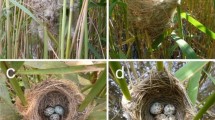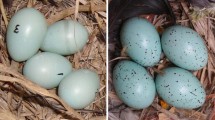The strategy used by the intraspecific brood parasite, the grey starling, Sturnus cineraceus (Temminck) and the degree to which this strategy reflected the sources of mortality for parasite eggs were examined. Approximately 74% of all parasite eggs failed to produce young that survived to fledglings. Most of this mortality was due to two factors: (i) laying in a nest that had been deserted by a host during its nesting cycle (19%); and (ii) mismatched timing of laying in the host’s nesting cycle (38%). It is important for parasites to select a suitable host in order to avoid this mortality and increase their reproductive success. However, grey starlings did not select hosts on the basis of nest location, host characteristics, or laying date. Lack of attention to these factors implies a failure on the part of the grey starlings to recognize cues that could direct them to select host nests that would provide the best environment for their eggs. Although some egg loss and egg replacement occurred before clutch initiation by hosts, no evidence was found that parasitic birds removed host eggs after clutch initiation by hosts. These results suggest that parasites did not adopt a successful strategy for enhancing the survival rate of their own eggs.
Similar content being viewed by others
REFERENCES
Andersson M. (1984) Brood parasitism within species. In: Producers and Scroungers (ed. C. J. Barnard) pp. 195–228. Croom Helm, London.
Brown C. R. & Brown M. B. (1989) Behavioural dynamics of intraspecific brood parasitism in colonial cliff swallows. Animal Behaviour 37: 777–796.
Brown C. R. & Brown M. B. (1991) Selection of high-quality host nests by parasitic cliff swallows. Animal Behaviour 41: 457–465.
Bullough W. S. (1942) The reproductive cycles of the British Continental races of the starling (Sturnus vulgaris L.). Philosophical Transactions of Royal Society of London, Series B 231: 165–246.
Davies N. B. & Brooke M. L. (1988) Cuckoos versus reed warblers: Adaptations and counter-adaptations. Animal Behaviour 36: 262–284.
Emlen S. T. & Wrege P. H. (1986) Forced copulations and intra-specific parasitism: Two costs of social living in the white-fronted bee-eater. Ethology 71: 2–29.
Evans P. G. H. (1988) Intraspecific nest parasitism in the European Starling Sturnus vulgaris. Animal Behaviour 36: 1282–1294.
Feare C. J. (1991) Intraspecific nest parasitism in Starlings Sturnus vulgaris: Effects of disturbance on laying females. Ibis 133: 75–79.
Forslund P. & Larsson K. (1995) Intraspecific nest parasitism in the barnacle goose: Behavioural tactics of parasites and hosts. Animal Behaviour 50: 509–517.
Fraps R. M. (1965) Twenty-four hour periodicity in the mechanism of pituitary gonadotropin release for follicular maturation and ovulation in the chicken. Endocrinology 77: 5–18.
Friedmann H. (1955) The honey-guides. US National Museum Bulletin 208.
Gibbons D. W. (1986) Brood parasitism and cooperative nesting in the moorhen, Gallinula chloropus. Behavioral Ecology and Sociobiology 19: 221–232.
Lack D. (1968) Ecological Adaptations for Breeding Birds. Methuen, London.
Lombardo M. P., Power H. W., Stouffer P. C., Romagnano L.C., Hoffenberg A. S. (1989) Egg removal and intraspecific brood parasitism in the European Starling (Sturnus vulgaris). Behavioral Ecology and Sociobiology 24: 217–223.
Lyon B. E. (1993) Tactics of parasitic American coots: Host choice and the pattern of egg dispersion among host nests. Behavioral Ecology and Sociobiology 33: 87–100.
McRae S. B. & Burke T. (1996) Intraspecific brood parasitism in the moorhen: Parentage and parasite-host relationships determined by DNA fingerprinting. Behavioral Ecology and Sociobiology 38: 115–129.
Møller A. P. (1989) Intraspecific nest parasitism in the swallow Hirundo restica: The importance of neighbors. Behavioral Ecology and Sociobiology 25: 33–38.
Nicolai J. (1974) Mimicry in parasitic birds. Scientific American 231: 92–98.
Payne R. B. (1977) The ecology of brood parasitism in birds. Annual Review of Ecological Systematics 8: 1–28.
Pinxten R., Eens M., Verheyen R. F. (1991) Conspecific nest parasitism in the European starling. Ardea 79: 15–30.
Power H. W., Litovich E., Lombardo M. P. (1981) Male starlings delay incubation to avoid being cuckolded. Auk 98: 386–389.
Rothstein S. I. (1990) A model system for coevolution: Avian brood parasitism. Annual Review of Ecological Systematics 21: 481–508.
Saitou T. (1986) Mate change in the grey starling. In: Reproductive Strategy of Birds (ed. S. Yamagishi) pp. 107–129. Tokai University Press.
Sandell M. I. & Diemer M. (1999) Intraspecific brood parasitism: A strategy for floating females in the European starling. Animal Behaviour 57: 197–202.
Sorenson M. D. (1997) Effects of intra- and interspecific brood parasitism on a precocial host, the canvasback, Aythya valisineria. Behavioral Ecology 8: 153–161.
Stouffer P. C., Kennedy E. D., Power H. W. (1987) Recognition and removal of intraspecific parasite eggs by starlings. Animal Behaviour 35: 1583–1584.
Warren D. C. & Scott H. M. (1935) The time factor in egg formation. Poultry Science 14: 195–207.
Woodard A. E. & Mather F. B. (1964) The timing of ovulation, movement of the ovum through the oviduct, pigmentation and shell deposition in Japanese quail (Coturnix coturnix japonica). Poultry Science 43: 1427–1432.
Yamaguchi Y. & Saitou T. (1997) Intraspecific nest parasitism in the grey starling (Sturnus cineraceus). Ecological Research 12: 211–221.
Yom-Tov Y. (1980) Intraspecific nest parasitism in birds. Biological Review 55: 93–108.
Author information
Authors and Affiliations
Corresponding author
About this article
Cite this article
Yamaguchi, Y. Parasitism strategy of the grey starling, Sturnus cineraceus: Selection based on host characters and nest location. Ecol Res 15, 113–120 (2000). https://doi.org/10.1046/j.1440-1703.2000.00334.x
Received:
Accepted:
Issue Date:
DOI: https://doi.org/10.1046/j.1440-1703.2000.00334.x




